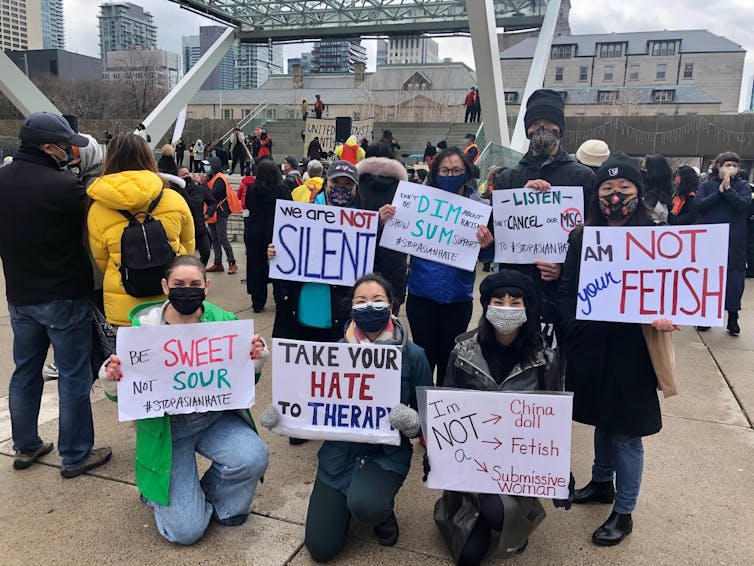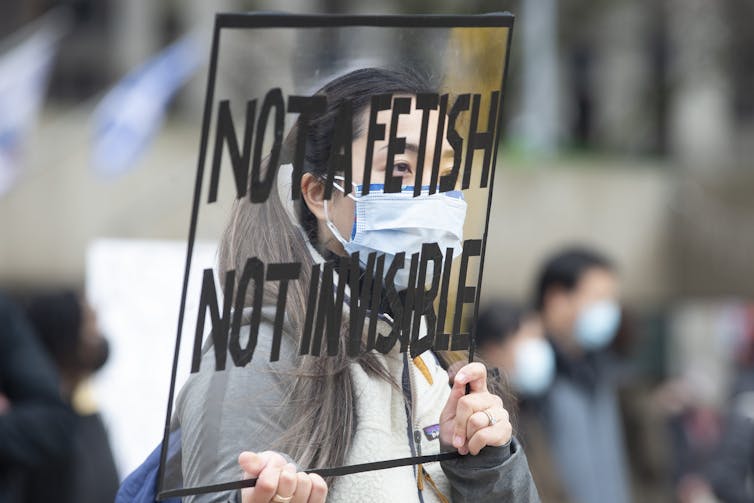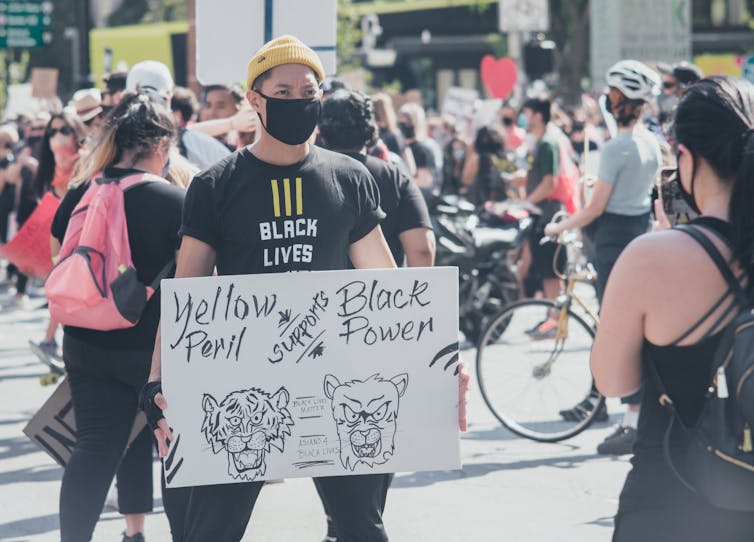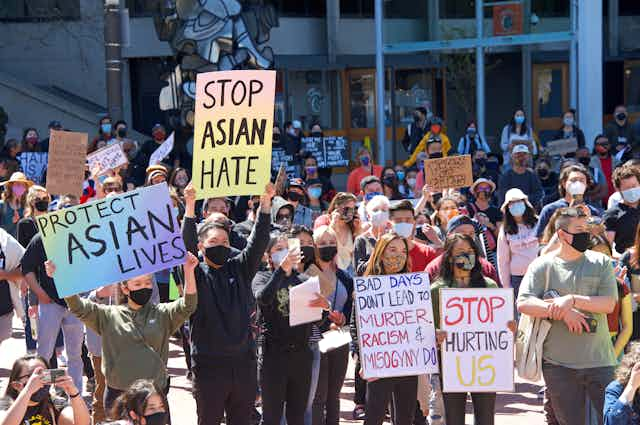And when I get excited
My little China girl says
Oh baby, just you shut your mouth
She says … shhhh
She says … shhhh
David Bowie’s China Girl did not make my life any easier growing up.
From being spit on to hit on and reduced to “China girl,” my experiences of anti-Asian racism marred my youth and adolescence, giving way to internalized oppression. Individual, institutional and systemic racism have longstanding and pervasive psychological damage.
The targeted killing earlier this year of eight people in Atlanta, six of them Asian women, was a catalyst sparking public outcry and rage, prompting Asians to speak out.
With an increase in anti-racist mobilization, emphasis on racial justice, recognition of sociopolitical factors and inclusivity and equity education alongside emphasis on Asian cultural pride, opportunity can emerge out of crisis.
Read more: As Asian Canadian scholars, we must #StopAsianHate by fighting all forms of racism
As we celebrate Asian Heritage Month, the time is now to collectively centre dialogue against anti-Asian racism, with an optimistic view for a global reset. I am a psychologist and professor comfortable in her academic bubble. But as an Asian woman who endured racism growing up, and with daughters who deserve a better future, I felt compelled to start a campaign and contribute to an Asian movement fighting racial intolerance.

Present turmoil provides opportunity
The recent rise in anti-Asian racism, subsequent protests and increased activism has sounded alarm bells for what’s reminiscent of legislated racism endured by Asian people in North America in the 19th century.
There was the internment of American and Canadian Japanese people during the Second World War. A head tax that was levied against Chinese immigrants in 1885; over the 38 years it was in place, nearly $23 million was collected from 82,000 Chinese immigrants. The Chinese Immigration Act, also known as the Chinese Exclusion Act of 1921 and other structural impediments, infringed upon human rights and normalized sinophobic rhetoric — the fear and disdain of Chinese people.
COVID-19 makes visible this century-old racism and has revived it into present day.
Read more: History of Asian activism tells us to share the burden of responsibility in fighting racism
April saw progress with Illinois passing a bill mandating Asian American history be taught in schools, the U.S. Senate overwhelmingly passed a bill that would help combat the rise of hate crimes against Asian Americans, and Canada’s federal budget announced $11 million over two years to expand the activities of the Canadian Race Relations Foundation. But much more is needed.
Anti-Asian racism is taking a heavy mental and emotional toll on Asian communities globally. Recognizing the psychological impact faced by these communities can help with progress. It allows for the development of specific mental health programs and interventions targeting the negative health effects of racism among marginalized people which can improve the lives of Asian people globally.

Psychological impact of anti-Asian hate, racism
With over 150 million confirmed cases of COVID-19, worldwide and more than three million deaths, incalculable changes have upended every facet of life.
Pandemic suffering of collective trauma is exacerbated for those experiencing race-based marginalization and discrimination. This can include heightened fear, unease, indecisiveness, anxiety, confusion, depression, deep mistrust, post-traumatic stress disorder, internalized racism, suicidality and substance abuse.
Race-related traumatic stress has been shown to increase cortisol levels, leading to poor health, cognitive and mental health decline and earlier death. Exposure to racial microaggressions such as being shunned, treated rudely and unfairly, hassled or made to feel inferior can have long-term effects on mental health.
It is also important to recognize that anti-Asian racism has disproportionately affected the elderly, women and youth. Women make up nearly 70 per cent of the reported 3,800 anti-Asian hate incidents in the U.S. and more than 60 per cent of the reported 1,150 cases in Canada.
Instilling positive ethnic identification through family, school and peer support is ideal for buffering affects of discrimination and racism. Learning and speaking about historical trauma from a place of compassion sets the stage for healing, and makes way for genesis of cultural pride and feelings of greater safety.

Supporting Asian solidarity and allyship
The rise of anti-Asian racism has increased mobilized efforts to address longstanding discrimination.
Efforts made through organizations around the world such as Asian Australian Alliance, Fight COVID-19 Racism, ACT2End Racism, Stop AAPI Hate, Wash the Hate, Stop Hate UK and #IAmNotAVirus have all helped increase visibility of anti-Asian racism. Through their work, and the work of individuals globally, we’ve been able to encourage reporting and increase efforts to directly highlight harmful Asian stereotypes.
Read more: The model minority myth hides the racist and sexist violence experienced by Asian women
Asian people joined forces to protest anti-Black racism following the death of George Floyd, which demonstrated cross-racial coalitions to combat white supremacy. This defies how Asians are often racially triangulated in relation to Black and white people.

The Asian Gold Ribbon campaign
In the spirit of hope and optimism, I founded the Asian Gold Ribbon campaign because I decided I could no longer stay invisible, meek and voiceless.
The Asian Gold Ribbon campaign compels individuals, organizations and communities to demonstrate solidarity against anti-Asian racism and recognize its profound psychological impact. It calls for people to support healing, amplify Asian voices and educate to raise awareness. It inspires an ongoing commitment for an Asian movement and involves community outreach, a visibility campaign and funds collected to increase Asian mental health services.
During the month of May, we are calling for people around the world to wear gold ribbons to celebrate Asian Heritage Month. The inaugural Asian Gold Ribbon Day is Thurs., May 20, 2021.
The campaign aims to compel social change and contribute to the momentum of a sustained 21st-century Asian movement. As racial justice for one vulnerable group reflects justice for others, we must work together to eliminate racism and inspire visible acts of solidarity together at this pivotal moment in time.
Support the campaign by wearing a gold ribbon on May 20.

